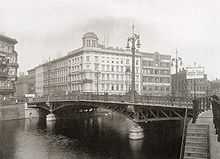Weidendammer Bridge
| Weidendammer Bridge Weidendammer Brücke (de) | |
|---|---|
 Weidendammer Bridge in 2006 | |
| Carries | Motor vehicles, trams, pedestrians and bicycles |
| Crosses | Spree |
| Locale | Berlin (Mitte) |
| Designer | Otto Stahn |
| Total length | 73 m (240 ft) |
| Width | 22.5 m (74 ft) |
| Longest span | 38.5 m (126 ft) |
| Opened | 1896 |

The Weidendammer Bridge is a 73 m (240 ft) long bridge where the Friedrichstrasse crosses the Spree river in the central Mitte district of Berlin, Germany. It is notable for its ornate wrought iron railings, lanterns and Imperial eagles.
.jpg)

History
In 1685 a wooden drawbridge was built on the site in the course of the creation under Elector Frederick William I of Hohenzollern of a new western suburb of the city, Dorotheenstadt. Named after nearby willow (Weiden) trees on the riverbank, it was demolished for a cast iron construction erected in 1824, one of the first in Central Europe. Again too small after the exponential population growth of Berlin as the capital of the German Empire, it was again replaced by the current bridge built between 1895 and 1896.

During the Battle of Berlin, the Weidendammer Bridge was one of the few Spree crossings that had not been destroyed. On the night of 1 May 1945, a Tiger tank from the 11th SS Panzergrenadier Division Nordland spearheaded an attempt to storm the bridge to allow hundreds of German soldiers and civilians to escape across it. However, it was destroyed by a Soviet anti-tank round, and many of the evacuees were mowed down by heavy enemy machine gun and small arms fire. There were three subsequent assaults on the bridge, one of which was led by a self-propelled gun and a half-track; all of which failed. During one of them Martin Bormann and Artur Axmann managed to cross the river by the bridge after escaping from the Führerbunker following Adolf Hitler’s suicide. However, Bormann was presumably killed several hours later, while Axmann evaded capture by the Soviets.
Lovers are known to lock padlocks engraved with their names onto the wrought-iron work on the bridge, and at times, these locks are removed by the authorities.[1]
References
- ↑ "In Love in Berlin - Love Padlocks on Berlin Bridges". Visit Berlin. Berlin Tourismus & Kongress GmbH. Retrieved 7 April 2012.
Coordinates: 52°31′20″N 13°23′17″E / 52.52222°N 13.38806°E